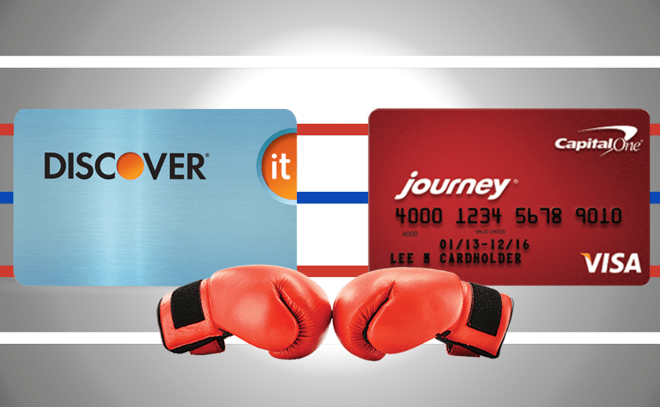2017 Comparison Review: Citibank Credit Card for Students vs. Discover it® for Students Card vs. BankAmericard for Students vs. Journey® Student Credit Card
You’ve finally graduated from high school after four years of dedication and hard work. Congratulations! The next step for many high school graduates is college. Last fall, more than 20.5 million students attended American colleges and universities, and that number has continually grown since 2000.
Whether it is a community college, in-state 4-year college, or out-of-state university, you are quickly heading into the adult world. Companies see the potential for a lifelong customer, so you might be getting what seems like endless credit card offers, like the Citi Student card or Discover it® Student credit card.



Source: Odyssey
Chances are, as you look through all of the applications and offers, your head starts spinning as much as it did when you were trying to choose the perfect college.
Much like the college selection process, it is worthwhile to take a detailed look at several credit cards like the Discover it® card for students and Citibank credit card for students before making your decision.
There are countless options out there for a student credit card, which is why we analyze four sound options for you. Throughout this review article, we will break down the different features of four student credit cards to see how they stack up against one another.
In what areas does the Discover it® for Students Card stand out? Does the Bank of America credit card for students have a better variable APR than the Citibank credit card for students or Capital One Journey® Student credit card? These are questions that you need answers to before making a final decision.
By delving into each of these cards and doing a thorough review of their features, you can decide what the best student credit card for you is: the Citi Student Card, Discover it® Card for Students, BankAmericard for Students, or the Journey® Student credit Card from Capital One.
Why Open a Student Credit Card?
There are many benefits to opening a student credit card like the Capital One Journey® credit card.
When you head to college, it is important to start building up your credit. After you graduate, you might want to get a new car, buy a house, or find yourself in student loan debt. Having an established, sound credit history with a card like the Bank of America student credit card can make conquering those things much easier.
Some credit cards like the Discover student card also offer introductory APR periods where you will not accrue interest on purchases for a set period of time. With the rising cost of textbooks, wouldn’t it be nice to pay them back in a few months instead of right away?
Another benefit is that a credit card will allow you to partake in the world of e-commerce. If you have a card like the Citibank student credit card, you can search for better deals on textbooks than the campus bookstores offer. Plus, wouldn’t that shag rug for your dorm be nicer if you could buy it for $50 less online?
These are just a few benefits of having a card like the Citibank student credit card. The main goal is to build up good credit, and with any of these credit cards, you can do just that.
Maintaining Good Credit Habits
If the main benefit to opening a student credit card is building up your credit, it is important to understand what constitutes as good credit habits. Using a card like the Citi student card has benefits, but you need to make sure that you use it responsibly. The following tips are important to keep in mind when you enter into the world of credit cards:
- Pay your bill on time, every time.
- Do not max out your credit card, but make sure you charge things regularly.
- Pay more than the minimum payment each month.
- Check your bill each month for errors and deal with problems promptly.
While there is more that goes into a credit score, these are good habits to get into with your first credit card. Whether you get the Bank of America credit card for students, the Capital One Journey® credit card, or one of the others, now is the crucial time to start building good credit habits. Your 25-year-old self who wants to get a new car or purchase a house will thank you!
Don’t Miss: Top Airline Credit Cards | Ranking | Best Airlines Miles Credit Cards (Reviews)
2017 Comparison Reviews
The list below is sorted alphabetically:
- BankAmericard® Credit Card for Students
- Capital One Journey® Student Credit Card
- Citi ThankYou® Preferred Card for College Students
- Discover it® for Students Card
Comparison Table:
Credit Card Names | Annual Percentage Rate (APR) | Annual Fee | Sign Up Bonus | Continual Rewards |
| BankAmericard® Credit Card for Students | 11.24–21.24% | None | None | None |
| Capital One Journey® Student Credit Card | 20.24% | None | None | Yes |
| Citi ThankYou® Preferred Card For College Students | 14.24–24.24% | None | 2.500 points | Yes |
| Discover it® for Students Card | 13.24–22.24% | None | Cash Back Match | Yes |
Table: Comparison Table | Above list is sorted alphabetically
Citibank Credit Card for Students vs. Bank of America Credit Card for Students vs. Discover it® Card for Students vs. Capital One Journey® Credit Card
Student credit cards like the Discover it® student credit card and BankAmericard for students all have unique features. You are able to apply for them with no little to no credit history, and that brings one thing to the forefront—this might be your first credit card.
Choosing your first credit card is a big responsibility, and it is important to consider all of the features on a student credit card like the Discover it® student credit card or Citi student card before you select one. It is crucial to pay close attention to the following specifics:
- Fees
- APRs & introductory offers
- Cash back rewards
- Sign-up bonus offers
Do not just fill out the first credit card application that you pick from the pile of offers. These credit card features can have a big impact on your financial future, and now is the perfect time to start building good credit habits with a student card like the Discover it® for Students Card.
Decide what features matter to you most, whether you care about annual fees, APRs, or rewards most, and base your final decision off that.
All-in-One Change Management Tools
Top Rated Toolkit for Change Managers.
Get Your Change Management Tool Today...
Fees
Fees are just another way that credit card companies make money. If a student card like the Capital One Journey® credit card is your first credit card, it is important to understand the different types of fees and how they work.
An annual fee is one that a credit card will charge you every year on your card anniversary. It is best to get a card that has no annual fee, which is why every credit card on our list has no annual fee. Whether you choose the Discover student card or one of the others, you will never see an annual fee.
The next fee to look at is a balance transfer fee. This is the amount charged to transfer a balance from another credit card or loan to your new card. It is generally the higher of a percentage or set dollar amount.
The Bank of America student credit card and Discover student card each have a 3% balance transfer fee, while the Citibank student credit card has a 4% fee. The Journey® credit card does not offer a balance transfer option, which is something to keep in mind.
Next on the fee list is a cash advance fee, which is the percent you are charged if you take a cash advance on your card. Both the Citibank student credit card and Discover student card have a 5% cash advance fee, which is the highest on our list. With a 3% fee, the Journey® credit card might be a good option for cash advances, while the Bank of America student credit card has a variable rate between 3 and 5 percent.



Image Source: Journey® credit card and Discover student card
Finally, there are foreign transaction fees, which is a fee for using your credit card outside of the United States. Thankfully, the Journey® credit card and Discover student card have no foreign transaction fees. The Bank of America student credit card and Citibank student credit card have a 3% fee, which is generally on the lower end for foreign transaction fees, but are still highest on our list.
Credit card fees are very important to understand. Make sure that you have a handle on the fees that you will be charged for using your credit card before you select one.
Related: Best Credit Cards for Bad Credit or No Credit | Guide | How to Find Bad Credit Credit Cards



APRs & Introductory Offers
An annual percentage rate (APR) is the annual rate you will be charged on the balance that you carry on your credit card. In simple terms, if you do not pay your credit card bill in full every month, this is the amount of interest that you will be charged on the balance.
When selecting a student credit card like the Bank of America student credit card, it is better to get a card with a lower APR. Especially if this is your first credit card and you may not have a steady income, it is better to have a lower APR when learning how the system works.
The Bank of America student credit card has the lowest variable APR, between 11.24% and 21.24%, while the Journey® credit card has a set APR of 20.24%. The Discover student card and Citibank student credit card fall in between these two, with variable APRs of 14.24–24.24% and 13.24–22.24% respectively.
Some credit card companies also offer introductory APR periods. During this period, you will not accrue any interest for whatever the specified time period is. This is generally between 3 and 21 months for cards with such offers.
A card like the Discover student card or Citibank student credit card with introductory APR offers are great options, especially for someone heading to college. You can pay for your college textbooks, meal plans, and even dorm room necessities, and take 6 to 7 months to pay them off entirely. This is definitely an offer to consider taking advantage of.
Cash Back Rewards
Cash back or rewards programs are a great feature to have, especially in a student credit card. Chances are that you won’t be charging large amounts on your credit card, but you can still earn some decent rewards with some of these credit cards, like the Citibank student credit card. The beauty of cash back is that it’s essentially earning rewards on purchases you would be making anyway.
The Bank of America student credit card, BankAmericard® Credit Card for Students, does not offer cash back. This isn’t a deal breaker since the card has other good features, but it is a nice feature to have in a credit card.
The Journey® credit card has a unique cash back system. You will earn just 1% on all purchases, but if you pay on time, that month’s cash back will be bumped to 1.25%. This is a good incentive to remind you to pay your bill on time.









The Citibank student credit card offers two ThankYou® Points per dollar spent at restaurants an entertainment. You will get one ThankYou® Point per dollar for all other purchases. These points do not expire, which is a great feature, and they can be redeemed for travel, home goods, gift cards, and even cash.
If you want strong rewards earning potential, the Discover student card is a good option to consider. Every three months, Discover has a new 5% cash back category, ranging from gasoline, and restaurants, to home improvement and department stores. You will also earn 1% cash back on all other purchases, and these can be redeemed for statement credits, merchandise, and gift cards.
Cash back rewards are a great way to be rewarded for purchases you would be making regardless. Though it’s a nice bonus to score a gift card or free merchandise, rewards programs should be viewed in combination with other features, like fees and APRs.
Popular Article: Discover vs Wells Fargo Secured Credit Card Review | Which Card Is Best?
Sign-Up Bonus
A sign-up bonus is a way for a credit card company to entice you to apply for their card. With all of the credit card offers that you receive, a big bonus might tip the scales in one card’s favor. Though a sign-up bonus on a card like the Citibank student credit card shouldn’t make or break your decision on whether to choose a card, it is definitely something to consider.
Right off the bat, the Capital One Journey® credit card and Bank of America student credit card fail this test. Neither card offers a sign-up bonus of any kind. It doesn’t exclude them from our consideration, but it is something to keep in mind.
The Citibank student credit card is the only one that offers an up-front sign-up bonus. You will get 2,500 bonus points if you spend $500 in the first 3 months. That’s just a little more than $150 a month, which is definitely achievable, even for a student.
Though it isn’t an up-front bonus, the Discover student card offers a bonus of a different kind. At the end of the first year, Discover will double the cash back that you have earned.
It is not a guarantee, but if you utilize the 5% cash back categories, this just might be more lucrative than the up-front bonus that you will get with the Citi ThankYou® Preferred Card for College Students.
Again, a sign-up bonus offer should not be the main decision criteria, but it is definitely a nice feature to have.
Conclusion: Bank of America Credit Card for Students vs. Citibank Student Credit Card vs. Discover student Card vs. Journey® Credit Card from Capital One
Choosing a student credit card is a big responsibility. There are many card options to consider, like the Discover it® for Students Card and Capital One Journey® Student credit card, among others.
When deciding which student credit card is best for you, you really need to break down the features of each of them. Remember to consider fees, APRs, introductory APR offers, cash back, rewards programs, and sign-up bonuses.


 Source: Studeonomics
Source: Studeonomics
Analyze the features of student cards like the Bank of America student credit card and Discover student card carefully, and decide what features are most beneficial to you.
Do you want an introductory APR offer like the Discover student card offers? Does having the lowest APR, which the Bank of America student credit card provides, seem most valuable to you? These questions are important to consider in the decision process.
Getting a student credit card to build up credit history is important, but choosing the right student credit card for you is crucial.
Read More: Top Interest-Free Credit Cards | Ranking | Best Zero Interest Credit Cards (Reviews)
AdvisoryHQ (AHQ) Disclaimer:
Reasonable efforts have been made by AdvisoryHQ to present accurate information, however all info is presented without warranty. Review AdvisoryHQ’s Terms for details. Also review each firm’s site for the most updated data, rates and info.
Note: Firms and products, including the one(s) reviewed above, may be AdvisoryHQ's affiliates. Click to view AdvisoryHQ's advertiser disclosures.



